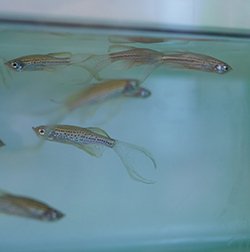Lessons from the Fishbowl
Solvay High School students get hooked on zebrafish at Syracuse University

Just before Spring Break, two dozen eighth and ninth graders filed into a biology lab at Syracuse University, where they were greeted by tanks of petite, stripped fish. Their assignment? To study the animals up close.
The students wasted no time in sizing up their subjects. The fish, staring back at them, had no comment.
Normally found in ponds and streams in India, the fish in question—zebrafish, or Danio rerio—have become popular among aquarium enthusiasts all over the world. But on this day, they’re stars of the University’s annual High School Biology Apprenticeship Day, held in the Life Sciences Complex.
Kate Lewis, associate professor of biology in the College of Arts and Sciences, has lead the outreach program for the past four years, hosting dozens of high school students from the city of Syracuse and Central New York. Two years ago, Lewis was awarded a National Science Foundation grant for her research work to identify the key regulatory genes that instruct cells to grow into a particular population of spinal cord nerve cells. A component of that NSF grant has partially funded the yearly High School Biology Apprenticeship Day program, and empowered her to help more young women and under represented minority students participate in STEM (science, technology, engineering and math) projects.
"Students get to do some real hands-on work, which hopefully expands and deepens their biological knowledge,” says Lewis, who uses zebrafish to better understand the role of neurons in the central nervous system. “We hope this experience gets them even more excited about science—especially, biology—and inspires them to pursue it in college.”
Aided by a team of graduate and undergraduate biologists, Lewis spent the afternoon guiding the students through a series of experiments, demonstrating how a microscopic fish embryo evolves from a simple cell cluster into a complex system of fins and gills.
In the process, students received hands-on training in cell biology, sexual characteristics, mutations, phenotypes, and nerve-cell development.
“Female zebrafish can lay hundreds of eggs in a single day,” she says. “The surrounding chorion, or egg shell, of each embryo is highly transparent, making the species an excellent subject for genetic studies.”
Lewis says students particularly enjoyed viewing green florescent protein with a UV light under a microscope. “These glowing cells allow us to see, in detail, how embryonic circulatory systems function,” she adds.
At the end of the day, each student received a special certificate—a souvenir of an unforgettable day at Syracuse and, for many, the passport to further scientific adventures.
